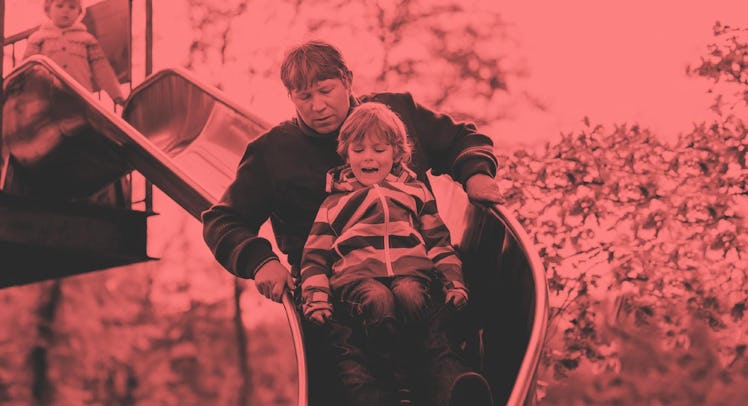Sliding With Toddlers Is Dangerous, According to 13 Years Of ER Data
Remember how you let your kid sit on your lap on the slide? Ya, don't do that.

When parents go down a slide with a young child on their laps, they’re putting their kids at risk for serious injury according to a new study presented at the American Academy of Pediatrics. While the idea may seem counterintuitive to some parents (after all, sliding with dad must be safer than sliding alone), the authors of the study emphasize that sliding with your kid on your lap puts them in harm’s way—particularly when gravity, weight, and inertia meet with a sickening crunch.
Many parents have no idea it’s unsafe. “In my experience parents are totally flabbergasted. This is something they hadn’t heard about, didn’t know it might be a risk factor,” coauthor on the study Dr. Charles Jennissen of the University of Iowa Carver College of Medicine told Fatherly. “In fact, a lot say if they had known they wouldn’t have gone down with the child.”
Jennissen was inspired to conduct the research after a number of lower extremity injuries in children came through his emergency department, and all seemed to be related to co-sliding with an adult. In order to suss out if the injuries were represented an actual trend, he and his team sifted through 13 years of data connected to playground slide injuries in children under the age of five. They found that more than 300,000 children had been injured on playground slides in the past 13 years. That’s more than 60 injuries per day, most of them involving the lower extremities. A full 22 percent of the injuries occurred in children aged 12 to 24-months, marking toddlerhood as the most likely time for these injuries to occur. Meanwhile, 614 injuries were specifically tied to sitting on an adult’s lap. Virtually all of these involved shin injuries.
“What we found striking was that these children, who really shouldn’t be climbing up ladders themselves, were getting injured,” Jennissen says, highlighting the tender age of most sliding victims. And he has a logical supposition of why that might be the case. After all, parents want their child to enjoy the thrill of the playground, but slides simply are not accessible for little kids. “Most typically what people do is go up there with the child and go down the slide with the child on their lap.”
But once the parent has scooted awkwardly off the edge of the slide, physics takes over. “When they’re going down, the feet of the toddler will usually catch on the side of the slide and the weight of the adult, with significant momentum, allows the child’s leg to twist and be forced backwards as the adult’s weight forces the child forward,” Jennissen says.
He concedes that parents likely won’t heed the warning and stop sliding with their kids altogether and, in any case, Jennissen has little desire to be a co-sliding abolitionist. Instead, he says he hopes parents will take extra precautions after learning of his study. “They really have to secure the legs and feet so they don’t catch the sides of the slide,” he says.
This article was originally published on